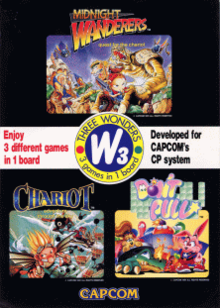Three Wonders
| Three Wonders | |
|---|---|
 Three Wonders arcade flyer | |
| Developer(s) | Capcom |
| Publisher(s) | Arcade: Capcom PS1, Saturn: Xing Entertainment |
| Director(s) | Yoshiki Okamoto |
| Designer(s) | Toshihiko Uda |
| Programmer(s) | Koma Chan |
| Composer(s) | Masaki Izutani |
| Platform(s) | Arcade, PlayStation, Sega Saturn |
| Release | Arcade May 20, 1991 PlayStation, Saturn 1998 |
| Genre(s) | Platformer, scrolling shooter, puzzle |
| Mode(s) | Single-player, multiplayer |
| Arcade system | CP System |
Three Wonders[a] is a 1991 video game collection developed and published by Capcom, originally released for the arcades using the CPS-1 platform.[1] It includes three related titles: Midnight Wanderers: Quest for the Chariot,[b] a platformer; Chariot: Adventure through the Sky,[c] a scrolling shooter; and Don't Pull,[d] a puzzle video game.
Gameplay[edit]
Midnight Wanderers[edit]
A platform game that sees the player control a hobbit named Lou and his travelling companion, Siva, to run, climb, and shoot at enemies to fight a villain who is turning their people into wooden statues.
Chariot[edit]
A scrolling shooter game featuring the characters from Midnight Wanderers flying in their chariots to save their home planet and princess.
Don't Pull[edit]
A puzzle game similar to games like the Adventures of Lolo series, Pengo, and Capcom's own puzzle game Pirate Ship Higemaru. It involves the player controlling either a rabbit named Don (Player 1) or a squirrel called Pull (Player 2), pushing blocks to crush monsters.
Lou appears also in Marvel vs. Capcom: Clash of Super Heroes as an assist character in game. He was also playable character on Capcom Super League, from Kakao Games, a mobile tactical RPG crossover on beta-test (2018-2019).
Development and release[edit]
Three Wonders was released in the arcades on May 20, 1991. A version for the Capcom Power System Changer was planned and previewed but never released.[2]
In 1998, it was ported to the PlayStation and Sega Saturn and published by Xing Entertainment. Three Wonders was also included in the 2006 Capcom Classics Collection Vol. 2 on the PlayStation 2 and Xbox, Capcom Classics Collection Remixed on the PSP and Capcom Arcade 2nd Stadium.
Reception[edit]
In Japan, Game Machine listed Three Wonders on their August 1, 1991 issue as being the fifth most-successful table arcade unit of the month.[3] Retro Gamer regarded 3 Wonders as a good alternative to Biomechanical Toy.[4] GameFan reviewed the PlayStation version as inferior to the original arcade game due to bad quality converted graphics.[5]
Notes[edit]
References[edit]
- ^ "Three Wonders". Hardcore Gaming 101.
- ^ "カプコン アーケードオリジナルボード CPSシリーズ+CPSチェンジャー 限定販売決定!!". Club Capcom (in Japanese). Vol. 2. Capcom. Spring 1994. pp. 90–91.
- ^ "Game Machine's Best Hit Games 25 - テーブル型TVゲーム機 (Table Videos)". Game Machine (in Japanese). No. 408. Amusement Press, Inc. 1 August 1991. p. 25.
- ^ "Converted Alternative - 3 Wonders". Retro Gamer. No. 74. Imagine Publishing. p. 20.
- ^ "R Review - Three Wonders". Retro Gamer. Vol. 6, no. 6. June 1998. p. 91.
